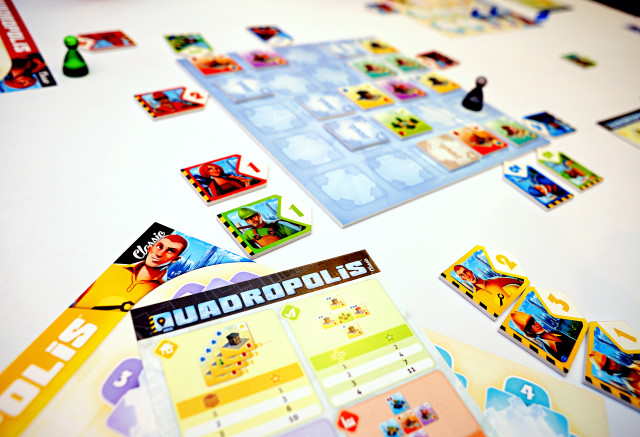Planning a city is hard work. You have to try and avoid putting factories next to apartment buildings and keep your parks away from smelly harbours. You want to produce the kind of town that is free of pollution and unemployment and works for both industries and residents alike.
The answer to everything in Quadropolis is four. You play four rounds, four turns per round and the scoring is based on multiples of four. In Quadropolis each of the players will be constructing their own city. To do so they will be taking building tiles from a central board. Everyone will be trying to get their hands on similar tiles, so the key will be to identify which buildings will work best for you, but also what are your opponents hoping to nab.
In the classic version of the game you have a team of architects working for you, numbered from one to four. The central board of building tiles is a 5×5 grid. On a turn, players will use one of their architects to snag a building tile and then add it to their city. The trick is that the architect you use will not only determine what tile you can take, but also where you can place it in  your city. They can be placed on any side of the board and the number of architect used indicates how many spaces in you will count when taking your tile. Many of the building tiles can be acquired by several different architects. That’s going to make a difference when you want to place that tile in your city. Each player’s city is a 4×4 grid with the columns and rows numbered one to four. If a player takes a building tile with their number three architect it must be placed in the city in either the three row or the three column. This gets trickier and trickier as both the buildings on the central board start to diminish and the city on player’s mats begins to grow. Players can find themselves taking buildings that don’t necessarily help their cause, or even sometimes unable to get a building at all.
your city. They can be placed on any side of the board and the number of architect used indicates how many spaces in you will count when taking your tile. Many of the building tiles can be acquired by several different architects. That’s going to make a difference when you want to place that tile in your city. Each player’s city is a 4×4 grid with the columns and rows numbered one to four. If a player takes a building tile with their number three architect it must be placed in the city in either the three row or the three column. This gets trickier and trickier as both the buildings on the central board start to diminish and the city on player’s mats begins to grow. Players can find themselves taking buildings that don’t necessarily help their cause, or even sometimes unable to get a building at all.
Every time a architect is used to grab a tile from the central board the Urbanist pawn is moved to the location of the taken tile. The Urbanist further complicates life for the city planners. When choosing where to aim their architect players can never point it in the row or column containing the Urbanist. The building a player wants might still be out there, but depending on the location of the Urbanist, they may or may not be able to get their hands on it. Very quickly the central board gets tighter and tighter as the options begin to diminish.
There are two main resources in the game that come to players as they lay down buildings. Some provide People and some provide Power. Now I want  to pause to just say that the little translucent people and power tokens are quite beautiful and eye catching. They make what is already a visually stunning game, that more more easy on the eyes. These resources are pretty important. They are used to activate buildings and any building that is not activated at the end of the game is swept off the board and not considered during final scoring. So players definitely want to make sure that each building that requires them has either power or a person working in them. However too much of either of the resources can be a bad thing. Leftover people at the end of the game represents unemployment and will cost a point for each one in a player’s city. Leftover power is pollution and who wants to live in a polluted city? Pollution is also going to cost the player a point at the game end. When resources are gained by placing down a building tile, players take them immediately from the supply. The resources can be placed out in their city immediately as a visual reference to what is activated and what still requires resources, but that placement is not locked in until the end of the game. Resources can be moved freely until final scoring to optimize their usefulness.
to pause to just say that the little translucent people and power tokens are quite beautiful and eye catching. They make what is already a visually stunning game, that more more easy on the eyes. These resources are pretty important. They are used to activate buildings and any building that is not activated at the end of the game is swept off the board and not considered during final scoring. So players definitely want to make sure that each building that requires them has either power or a person working in them. However too much of either of the resources can be a bad thing. Leftover people at the end of the game represents unemployment and will cost a point for each one in a player’s city. Leftover power is pollution and who wants to live in a polluted city? Pollution is also going to cost the player a point at the game end. When resources are gained by placing down a building tile, players take them immediately from the supply. The resources can be placed out in their city immediately as a visual reference to what is activated and what still requires resources, but that placement is not locked in until the end of the game. Resources can be moved freely until final scoring to optimize their usefulness.
So what kind of buildings can players get their hands on for their city? In the classic version their are six different types of buildings, each with their own scoring conditions. Apartment buildings can be stacked and will yield points depending on their height. Parks earn points for being adjacent to apartment buildings. Parks can also allow players to remove one pollution token at the end of the game. Shops want customers and will get points based on the number of people they have in them at the end of the game. Factories serve Shops and Harbours. They’ll generate points for being beside those types of buildings. Public Works buildings earn points for being spread out. Having a Public Works in each of four quadrants is the goal. Finally Harbours are going to earn points for the longest row and the longest column of continuous Harbours in a player’s city.
Now you’ve probably been hearing a lot of talk about classic versions of  Quadropolis and you’re asking what other versions are there? The Expert version ups the complexity of the gameplay a bit. The city boards become 5×5 grids, new buildings enter the fray and the way architects work changes as well. Instead of everyone having their own team of architects numbered one to four they are all flipped to their grey side and form a central pool. On a turn, players may select the architect that will serve them best depending on the board state. That means that in a round someone may use three Two architects and one Four architect if that’s what makes the most sense for them. The added layer of complexity is a nice touch and adds a level of replayability.
Quadropolis and you’re asking what other versions are there? The Expert version ups the complexity of the gameplay a bit. The city boards become 5×5 grids, new buildings enter the fray and the way architects work changes as well. Instead of everyone having their own team of architects numbered one to four they are all flipped to their grey side and form a central pool. On a turn, players may select the architect that will serve them best depending on the board state. That means that in a round someone may use three Two architects and one Four architect if that’s what makes the most sense for them. The added layer of complexity is a nice touch and adds a level of replayability.
Coming fresh from BGGcon, I can say with some confidence that the people who stopped by the Days of Wonder booth were pretty universally excited about Quadropolis. Coming into the con I hadn’t heard much about it, but I’m now hotly anticipating its March release. The beautiful art and components make Quadropolis very attractive at a glance and people were going nuts for the see-through resources. The simple rule set will suck players in, but it is the depth of complex decisions you can make and hidden layers of strategy that made this game one of the hits of the convention.
A very nice preview of a game I am looking so much forward too. Thanks for sharing your thoughts and the nice images 🙂
Thanks for your comment Peter!
This looks beautiful, the pictures are amazing! What a great preview. Really excited for this game 🙂
[…] Thumbnail from http://www.dailyworkerplacement.com […]